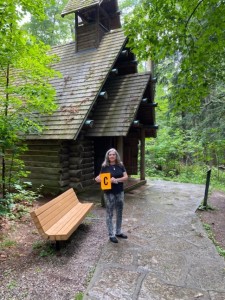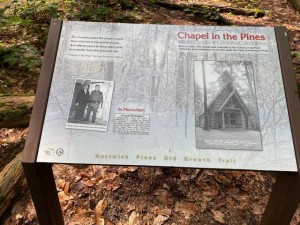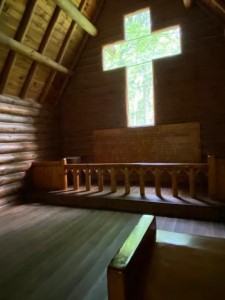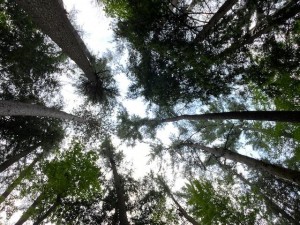Hartwick Pines State Park is the only place in Michigan which still holds the towering White Pines, which once covered the entire state and built the wealth of countless lumber barons. Today, there are just 49 acres of the trees, in the entire state! This area, was the third city along our 48 hour Michigan tour, which is why we dedicated the third letter of the alphabet, “C”, to discovering the tiny “chapel” which sits in the middle of the forest.
The chapel quietly appears after a short walk through the towering pines. I was so excited to see this cabin-like structure, which was a big reason we had gone so far out of our way to include Grayling in our adventure. The chapel was intended to be a place of spiritual reflection and meditation for “all who walk the trails of Hartwick Pines”. The first thing I noticed was the beautiful curved glass, which makes up the window and forms a “cross”.
A brief history informed me that this is actually a fairly new structure, having been built and dedicated in 1953.
Making our way to the entrance of the church, the light filters through the window. I imagine how spectacular this space might be in the morning, as the sun rises and floods the tiny chapel. I think of the married lives which might have begun here. I can visualize the light washing over people, flooding them with warmth. For now, the sun has already moved beyond the window so there is just enough light to see the pews. I take my place amongst one of the tiny benches, which line both side of the chapel. The chapel only holds 18 people. I am the only person here at the moment, Alan waits outside as I spend a moment in silent meditation.
A plaque positioned under the window reads:
Our Heavenly Father, Creator of all that is nature,
We humbly come to you in the midst of nature’s splendor,
To thank you that as Americans we are free
To worship as we please, work as we please,
And move about as we please to enjoy all that is nature:
Its mountains, its hills, its valleys, its lakes,
Its streams, and the living things that dwell therein;
We pray unto You that someday the world may be at peace
And all men be free to enjoy nature’s abundance.
We ask you in the name of the Lord Jesus Christ
That we be guided to protect this priceless heritage
Which we, in America, are privileged to enjoy. Amen.
Following the Covid outbreak, which has so divided this country, what a year (or two) it has been. Uttering this small prayer of hope, instantly fills me with a sense of “calm”. I step from the chapel feeling just a bit lighter, as I return to the forest for the remainder of our walk in the woods.




